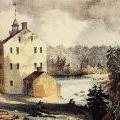 The leader-associate system failed to bring about the expected settlement of the Eastern Townships. Land held by speculators was kept undeveloped and off the market. Speculators were waiting for the pioneers to clear their lands and build roads, schools, and churches. Once this happened, they knew that more settlers would want to come, land prices would rise, and their profits would soar. In the meanwhile, pioneers and their families were breaking their backs making these improvements, and the speculators were not contributing their share. Some people grew frustrated and left for Ontario or the American West.
The leader-associate system failed to bring about the expected settlement of the Eastern Townships. Land held by speculators was kept undeveloped and off the market. Speculators were waiting for the pioneers to clear their lands and build roads, schools, and churches. Once this happened, they knew that more settlers would want to come, land prices would rise, and their profits would soar. In the meanwhile, pioneers and their families were breaking their backs making these improvements, and the speculators were not contributing their share. Some people grew frustrated and left for Ontario or the American West.
The British American Land Company:
The government introduced a new system in 1832 with the sale of a vast tract of land to the English-based British American Land Company. To make a profit on its investment, the Company would have to sell land to settlers. To do this, it would have to make the area more attractive than Ontario or the American West. It did this with misleading advertising directed to prospective immigrants in Great Britain. However, the Company also improved transportation and spent a great deal of money building mills and schools in villages, initiatives which it hoped would attract more British settlers.
The advent of the British American Land Company coincided with the large scale social and economic upheaval associated with the Industrial Revolution in Great Britain. Skilled English tradesmen were being replaced by machines. The lands of Scottish tenant farmers were being converted to sheep grazing because more wool was needed to supply the new textile mills.
The Irish:
The Irish were fleeing from general economic depression and famine. Many Irish peasants, like the Highland Scots, were being evicted by their landlords. Significant numbers of them would settle in the Townships, particularly in the area around Richmond.
The Scots:
Generally the British were less adapted than the Americans to pioneer farming. Little in their experience would prepare them for the harsh conditions they would face. The Gaelic-speaking Highland Scots, however, were among the hardiest of Townships pioneers. Fifty acres of uncleared land in Megantic or Compton was a vast estate in comparison with the tiny plots of land they had farmed in Scotland. Furthermore, their farms would be their own - no more landlords.
Perhaps the least successful of the British settlers were the English gentlemen and their families who were expecting a class system like in England and hoping to become lords of a manor. They found labour much too expensive and Townshippers much too Yankee. English tradesmen fared better in the many villages that were developing. Most of the Irish had only their unskilled labour to offer, and there was little opportunity in the Eastern Townships before the Industrial Revolution.